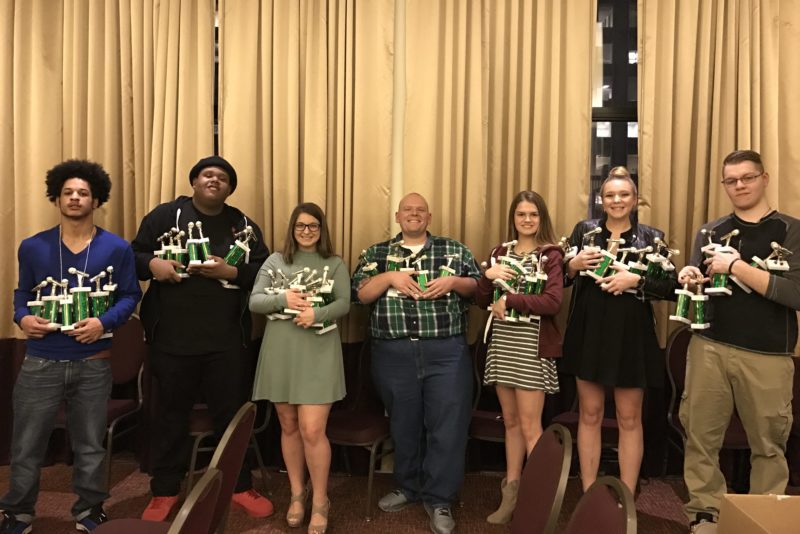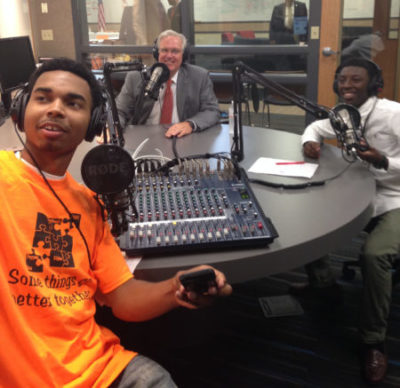 The work coming out of KRHS 90.1 FM and KRHS TV News, based in Ritenour High School in St. Louis, Mo., is a great example of what happens when district officials invest in public schools.
The work coming out of KRHS 90.1 FM and KRHS TV News, based in Ritenour High School in St. Louis, Mo., is a great example of what happens when district officials invest in public schools.
In 2013, a $1.25 million investment into the high school’s 36-year old journalism program created a high-end broadcast suite, complete with a radio station, television news studio, editing bays, conference rooms, and space for the student newspaper and yearbook. What followed was an unmatched level of performance that earned students and teachers state and national recognition.
Last March, the school’s journalism students made their best showing yet when they traveled to a national competition in New York City and returned home with the Intercollegiate Broadcast System’s Best High School Radio Station award—the Oscars of high school radio—and 38 other trophies.
“If we really are the best, these are the things the kids need,” says Jane Bannester, a broadcast journalism teacher, who helps lead the school’s television and radio programs. “We worked hard to honor the school and its investment by showing that our students can be just as successful as kids in any other school district,” including those in more affluent areas, she underscores.
Three years of hard work paved the way toward the awards. Students went beyond the everyday school announcements and addressed tough topics.
Tackling Race
 Students Jeremy Fips and Marcus Jordan interview—and take a “selfie” with then-Governor Jay Nixon in the KRHS 90.1 FM radio studio.
Students Jeremy Fips and Marcus Jordan interview—and take a “selfie” with then-Governor Jay Nixon in the KRHS 90.1 FM radio studio.
A year after Ritenour High School’s doors to the revamped media center opened, “Ferguson happened,” says Bannester, referring to the St. Louis suburb where Michael Brown, an unarmed Black teenager, was shot and killed by a White police officer.
Just 6 miles stand between Ritenour and Ferguson, and the shooting sparked weeks of protests.
“Ferguson isn’t somebody else’s story. It’s the story of many of our kids,” explains Bannester, who was recently named Missouri’s Journalism Teacher of the Year.
“Students were very impassioned by it no matter their race…[and] we couldn’t just sit there and do nothing.”
School officials were supportive of journalism students’ desire to address the issue. The principal connected students with community organizations that worked on race relations. To help develop their reporting and interviewing skills, students were paired with mentors. Journalists from the St. Louis Post-Dispatch and the local NPR station worked with students, too.
“If we really are the best, these are the things the kids need. We worked hard to honor the school and its investment by showing that our students can be just as successful as kids in any other school district” - Jane Bannester, broadcast journalism teacher
The young people immediately went to work, inviting the Missouri governor and chief of police to the studio for a live radio interview. They went outside of the school to cover major news conferences and summits, where they interviewed teen activists who shared personal stories about the impact of race within their lives, and their thoughts about the fatal shooting of Brown.
Bannester led the students every step of the way, and helped them produce high-end news audio that included live broadcasts and a podcast series, as well as video packages.
“Their work on a story went from taking a month to a couple of days,” says Bannester, “and they were taking computers home to edit for themselves because they wanted to get that story done.”
Connections students made from the Ferguson coverage also created the opportunity for Ritenour’s radio and television stations to become the lead media outlet for Gateway2Change, a program that engages students on race and diversity, and provides a platform for them to be active social reform agents.
The program offered several student summits that centered on social and cultural differences within communities, and examined ways to come together in effective, positive ways. Ritenour journalism students were there to cover it all.
“This is what you want for your students and program,” says Bannester, who has led the broadcast program for the past 12 of her 20-year career. “You want it to grow outside of just your school and into more opportunities.”
Photos: Jane Bannester








